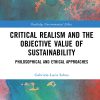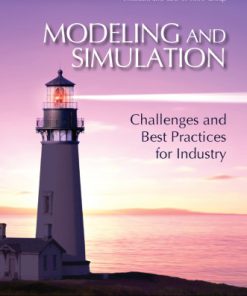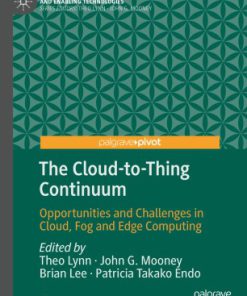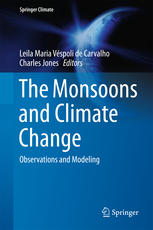Marine Fog Challenges and Advancements in Observations Modeling and Forecasting 1st Edition by Darko Koračin, Clive Dorman ISBN 9783319452296 3319452290
$50.00 Original price was: $50.00.$25.00Current price is: $25.00.
Marine Fog Challenges and Advancements in Observations Modeling and Forecasting 1st Edition by Darko Koračin, Clive Dorman – Ebook PDF Instant Download/Delivery: 9783319452296 ,3319452290
Full download Marine Fog Challenges and Advancements in Observations Modeling and Forecasting 1st Edition after payment
Product details:
ISBN 10: 3319452290
ISBN 13: 9783319452296
Author: Darko Koračin, Clive Dorman
Marine Fog Challenges and Advancements in Observations Modeling and Forecasting 1st Edition Table of contents:
Chapter 1: Introduction
Chapter 2: Worldwide Marine Fog Occurrence and Climatology
1 Introduction
2 Present Weather Observations Over the Sea
2.1 Data Source
2.2 Methodology for the Fog Event Data Base
2.3 Percent of Occurrence and Adjustment
2.4 Data Base Specifics: Reporting Codes
2.5 Frequency Distribution of the Weather Codes in the Data Base
2.6 Zonal and Seasonal Distributions of Present Weather Code Observations
2.7 Fog Occurrence Uncertainty
3 Worldwide Marine Fog Occurrence
3.1 Mean Quarterly World Ocean Analyses: Number of Observations
3.2 Mean Quarterly World Ocean Analyses: Fog, Code 40s
3.3 Mean Quarterly World Ocean Analyses, Shallow Fog: Codes 11 and 12
3.4 Mean Quarterly World Ocean Analyses, Mist: Code 10
3.5 Summer Polar Region Fog Analyses
4 Open Ocean Areas with Maximum Occurrence of Fog
4.1 NW Pacific
4.2 NW Atlantic
4.3 Southern Ocean
5 Wind-Driven Coastal Upwelling Zones
5.1 Wind-Driven Coastal Upwelling
5.2 California-Oregon
5.2.1 ICOADS Observations
5.2.2 ICOADS Observations Compared to Another Study and Coastal Stations
5.2.3 Fog Relationships and Causes
5.3 NW Africa
5.3.1 ICOADS Observations
5.3.2 ICOADS Compared to Other Studies and Coastal Stations
5.3.3 Fog Relationships and Causes
5.4 SW Africa
5.4.1 ICOADS Observations
5.4.2 ICOADS Observations Compared With Coastal Stations
5.4.3 Fog Relationships and Causes
5.5 Peru and Chile
5.5.1 ICOADS Observations
5.5.2 ICOADS Observations Compared With Coastal Stations
5.5.3 Fog Relationships and Stratus Clouds
5.6 NW Indian Ocean (Arabian Peninsula)
5.6.1 ICOADS Observations
5.6.2 ICOADS Observations Compared to a Coastal Station
5.6.3 Fog Relationships and Causes
5.7 Fog Occurrence and SST in the Wind Driven Coastal Upwelling Areas
6 Marginal Seas and Coasts
6.1 Yellow Sea, China Coast and South China Sea
6.1.1 ICOADS Observations
6.1.2 ICOADS Observations Compared to Coastal Stations and Other Studies
6.1.3 Fog Relationships and Causes
6.2 Japan Sea
6.2.1 ICOADS Observations
6.2.2 ICOADS Observations Compared to Coastal Stations and Other Studies
6.2.3 Fog Relationships and Causes
6.3 Sea of Okhotsk, Kuril Islands, Japan
6.3.1 ICOADS Observations
6.3.2 ICOADS Observations Compared to Other Studies, Fog Relationships and Causes
6.4 NE United States: Canada
6.4.1 ICOADS Observations
6.4.2 ICOADS Fog Maximum Along SW Nova Scotia and Coastal Upwelling
6.4.3 ICOADS Observations Compared to Coastal Stations and Other Studies
6.4.4 Fog Relationships and Other Causes
6.5 Labrador Sea and Grand Banks
6.5.1 ICOADS Observations
6.6 Europe
6.6.1 ICOADS Observations
6.6.2 ICOADS Observations Compared to Coastal Stations and Other Studies
6.6.3 Fog Relationships and Causes
6.7 Other Areas
7 Fog Climatology: Long-Term Trend
7.1 NW Pacific
7.2 NW Atlantic
7.3 California-Oregon
7.4 Summary of Fog and SST Trends for 1950-2007
8 Discussion/Conclusion
References
Chapter 3: Early and Recent Observational Techniques for Fog
1 Purpose of This Chapter
2 Fog Definition
3 Basic Principles Behind Visibility: The Critical Variable
4 Weather Codes and International Organization
5 Temperatures and Humidity
5.1 General Introduction
5.2 Air Temperature and Humidity Probes: Slow Response
5.3 Air Temperature and Humidity Probes: Fast Response
5.4 Sea Surface Temperature
6 Surface Winds
6.1 General Introduction
6.2 Mechanical Wind Sensors: Separate Cup and Vane Components
6.3 Mechanical Wind Sensors: Combined Speed and Direction
6.4 Ultrasonic Wind Sensors
6.5 Ultrasonic Wind Sensors: Very Fast Response
6.6 Ultrasonic Wind Sensor and Gas Analyzer: Very Fast Response Systems
7 Precipitation
7.1 Precipitation Over Land
7.2 Precipitation Over Sea
7.3 Precipitation From Remote or Indirect Measurements
8 Visibility Observations Estimated by Eye
9 Instruments for Visibility Measurements
10 Downward Radiation
11 Present Weather Detection Systems
12 Atmospheric Particle Measurement
12.1 Overview
12.2 Representative Particle Measurement Systems
12.3 Liquid Water Content
12.4 Data Example
13 The Video Camera
14 Surface Automated Meteorological Station
15 Ceilometer
16 Radiosonde
17 Acoustical Wind Profiler
18 Radar
18.1 Vertical Profile Soundings: Microwave Radar
18.2 Vertical Profile Soundings: Radar Wind Profiler With RASS
18.3 Scanning Radar
19 LIDAR
20 Summary
Appendix 1: List of Selected Manufacturers and Vendors
References
Chapter 4: Turbulence in Marine Fog
1 Introduction
2 Determination of Turbulent Fluxes
2.1 Parameterized Turbulent Flux
2.2 Empirically Derived Turbulent Flux
3 Role of Turbulence in Advection Fogs
3.1 Understanding Fog Formation Mechanisms Using Parameterized Turbulent Flux
3.2 Understanding Fog Formation Mechanisms Using Empirically Derived Turbulent Flux
3.3 Thermal Internal Boundary Layer
4 Role of Turbulence in Steam Fogs
4.1 Necessary Conditions for the Onset of Steam Fog
4.2 Understanding Fog Formation Mechanisms Using Empirically Derived Turbulent Flux
5 Marine Fog Formation by Stratus Lowering
6 Concluding Remarks
References
Chapter 5: Radiation in Marine Fog
1 Introduction
2 Longwave Radiative Heating Rate
3 Role of Radiation on the Formation of Marine Fog
4 Role of Radiation on the Evolution of Marine Fog
5 Role of Radiation on the Dissipation of Marine Fog
6 Concluding Remarks
References
Chapter 6: Synoptic Processes
1 Introduction
2 Spatial and Temporal Distribution of Marine Fog Frequency
2.1 Northwestern Pacific
2.2 Chinese and Korean Adjacent Seas
3 Climatological Conditions for Marine Fog
3.1 Fog in the Northwestern Pacific
3.1.1 Meteorological Conditions
3.1.2 Influences of the Northwestern Pacific High and the Kuroshio Extension
3.1.3 The Impact of SST on Marine Fog
3.2 Fog in the Chinese Korean Adjacent Seas
3.2.1 The Conditions of Air-Sea Interface
3.2.2 The Stability in the MABL
3.2.3 Warm Sea Fog
4 Synoptic Processes in Fog Formation, Maintenance and Dissipation
4.1 Yellow Sea Fog in Springtime
4.1.1 Observations
4.1.2 Synoptic Conditions for the Fog Formation and Development
4.1.3 Fog Dissipation
4.2 Yellow Sea Fog in Summer
4.2.1 Observations
4.2.2 Synoptic Conditions for Fog Formation and Development
4.2.3 The dissipation of fog
4.3 Comparison of Radiative Cooling Effect Between Fogs in Spring and Summer
4.4 Yellow SEA FOG in Winter
4.5 South China Sea Fogs
4.5.1 Synoptic Pressure Patterns
4.6 Marine Fog Associated with the Mei-Yu Front in the Northwest Pacific
5 Summary
References
Chapter 7: Marine Fog: A Review on Microphysics and Visibility Prediction
1 Introduction
2 Fog Observations
3 Microphysics of Fog and Visibility
3.1 Fog Visibility Parameterization for NWP Models
3.2 Droplet Number Concentration Parameterization
3.3 Droplet Activation
3.4 Fog Deposition Rates
3.5 Remote Sensing Retrievals of Fog
3.5.1 Satellite Observations
3.5.2 Radar Observations
3.5.3 Lidar, Sodar, and Ceilometers
3.5.4 Microwave Radiometers
4 Fog Forecasting
4.1 Overview of Fog Forecasting
4.2 NWP and Fog Microphysical Parameterization
4.3 Ensemble Prediction System for Fog
4.4 Fog Prediction Using Neural Networks
4.5 Uncertainty in Visibility Observations
5 Future Challenges
5.1 Fog Physical and Dynamical Processes, and Solar Radiation
5.2 Marine Fog Based on Thermodynamical Conditions
5.3 Autoconversion Issues
5.4 Scale Issues
5.5 Cold Fog Issues
5.6 Visibility Observational Uncertainty
5.7 Fog and Climate Change
5.8 CO2 Warming Effect and Fog Dissipation
6 Conclusions
References
Chapter 8: Precipitation and Fog
1 Introduction
2 Overview of the Phenomenon
2.1 Where Does Precipitation Fog Occur?
2.2 Synoptic Scale Conditions
2.3 Local Conditions Leading to Precipitation Fog Formation
2.3.1 Temperature Inversions
2.3.2 Precipitation Types and Rates
2.3.3 Cloud Ceilings and Visibility
2.4 Summary
3 Physical Processes
3.1 Fog Formation
3.1.1 The Precipitation Evaporation Perspective
Evaporation of Nonequilibrium Raindrops
The Case of Melting/Freezing Hydrometeors
3.1.2 Adiabatic Cooling
3.1.3 Air-Sea Interactions and Turbulent Mixing
3.1.4 Radiative Cooling
3.2 Dissipation
4 Summary and Perspectives
References
Chapter 9: Modeling and Forecasting Marine Fog
1 Introduction
2 Early Studies
3 Some of the Basic Observational Studies of Marine Fog
4 Modeling and Forecasting of Marine Fog
4.1 Statistical Modeling and Forecasting
4.2 Dynamical Modeling- Historical Development
4.3 Summary
5 Research and Application Studies of Marine Fog- WorldwideViewpoint
5.1 Atlantic
5.2 U.S. West Coast
5.3 England and Scotland Coasts
5.4 Yellow Sea
5.5 China Sea
5.6 Other Regions
6 Concluding Remarks
References
Chapter 10: Ensemble Fog Prediction
1 Introduction
2 Sensitivity of Fog Prediction to Model IC and Physics
3 Improvement of Fog Forecasts Through Ensemble Approach
3.1 Fog Algorithm
3.2 Sensitivity of Fog-Related Variables to IC, Model Dynamic Core and Physics
3.3 Improvement in Deterministic Forecast Accuracy Through Ensemble
3.4 Advantage of Ensemble-Based Probabilistic Forecasts
4 Status of Operational Ensemble Prediction of Fog and Low Visibility
5 Verification of Ensemble Forecasts
5.1 Ensemble Mean
5.2 Ensemble Spread
5.3 Probability
6 Summary
Appendix: A Balance Theory Based Fog Algorithm for Fog Intensity
References
Chapter 11: Multi-spectral Remote Sensing of Sea Fog with Simultaneous Passive Infrared and Microwav
1 Introduction
2 Data and Methods
3 Yellow Sea Fog Case
4 South China Sea Fog Case
5 Subtropical Stratocumulus Case
6 Comparison of Cases
7 Summary and Future Prospects
References
Index
People also search for Marine Fog Challenges and Advancements in Observations Modeling and Forecasting 1st Edition:
what is marine fog
what causes marine layer fog
how to fog a marine engine
how
Tags:
Darko Koračin,Clive Dorman,Marine Fog Challenges,Advancements,Observations Modeling,Forecasting
You may also like…
Engineering
Modeling and Simulation : Challenges and Best Practices for Industry First Edition Dubois
Business & Economics
Science (General)
Advancements and Innovations in Health Sciences Mieczyslaw Pokorski
Politics & Philosophy - Government & Politics
Business & Economics - Management & Leadership
Biology and other natural sciences - Ecology
Climatology
Engineering - Industrial Engineering & Materials Science
Additive Manufacturing-Fundamentals and Advancements 1st Edition Manu Srivastava












